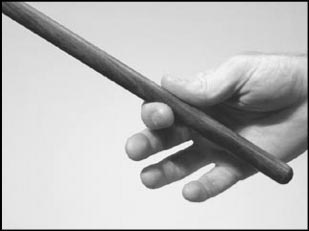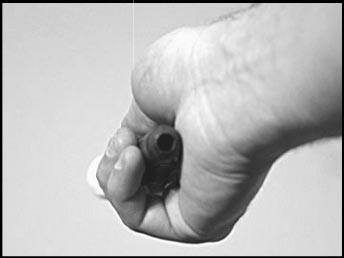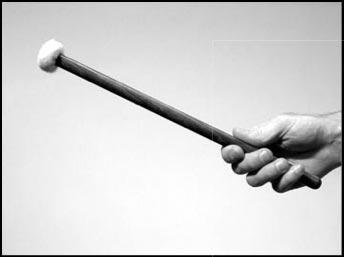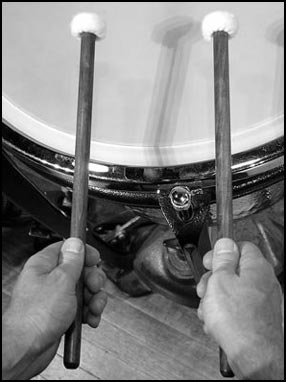Timpani
The French Grip
The Timpani grip has many of the same characteristics as the basic two-mallet grip. It also revolves around the concept of a relaxed and natural hand position. If you let your hand hang by your side you'll notice the natural curve of all your fingers.
Keep this look in mind as you go through the following setup:
- Place the mallet between the first knuckle of your index finger and the pad of your thumb. This is a very important contact point as it is the fulcrum, or pivot point of the mallet. Start with your fulcrum one-third of the way up the mallet shaft.
- The other fingers should wrap around the mallet in a curved and relaxed manner.
- Leave a little space between the mallet shaft and the palm of your hand. This will help to relax your stroke and allow you to use the natural rebound.
- When your hands are set and ready to play, your palms will face each other with your thumbs facing up. This should be a relaxed position. The mallet shafts will be close to parallel and the mallet heads will be from 6 to 8 inches apart.



Striking the Timpani
 It is important to remember that the Timpani should be struck in the same place on the head each time. If this is not done, a variety of uneven sounds are produced. There are times however, especially in contemporary music, when various sounds or timbres are desirable or required.
It is important to remember that the Timpani should be struck in the same place on the head each time. If this is not done, a variety of uneven sounds are produced. There are times however, especially in contemporary music, when various sounds or timbres are desirable or required.
- The motion used in striking the Timpani is that of wrist and fingers. No arm or elbow motion is used except to move from drum to drum.
- Rest the mallet on the drum three inches from the rim.
- Pinch the mallet firmly between the thumb and first finger. (Firm, but relaxed)
- With the wrist only, raise the mallet upward. When this is done, the second and third finger which were against the mallet, will fall away from it. The thumb and index finger are the only ones in contact with the stick at this point.
- When the stick strikes the drum, draw it away using the motion you used in step three. The mallet should naturally rebound off of the head after it is struck. Drawing the mallet away, and using the natural rebound of the head produces a more legato stroke. Drawing the mallet away more quickly produces a more staccato stroke. Variations in articulation fall anywhere in between.
Muffling
Because Timpani has natural sustain it is necessary to control the duration of the tone by muffling the drum based on the length of the note being played. To muffle the drum lightly touch the head with the fingertips. Extra care should be taken not to make a sound when touching the head. The object is to cut off the sustain, without producing an additional, percussive, "tack".
The written music will determine when to muffle. Observing full note lengths and rests is the general rule to follow – allow the drum to sustain the full value of the note (natural decay will occur, and this is appropriate). Muffiling doesn’t only apply to the last drum played. Any drum that might sustain through an approaching rest or silence should also be muffled.
Care should also be taken when a sustain from one drum might create a dissonance when moving to a different drum with a different pitch. It may be necessary to dampen the first drum in order to not create a dissonant sustain, much like one would dampen a vibraphone, bells or chimes in a similar situation.
Rolls
All rolls on Timpani are single stroke. Never use multiple bounce roll technique on Timpani unless the composer specifically asks for it as a special effect.
Tuning
Timpani is really the only pitched percussion instrument that requires tuning. In order to tune the Timpani, a percussionist must develop a good sense of "relative" pitch. Relative pitch can be defined in the following manner:
The term Relative Pitch may denote:
- the distance of a musical note from a set point of reference, e.g. "three octaves above middle C"
- a musician's ability to identify the intervals between given tones, regardless of their relation to concert pitch (A = 440 Hz)
- the skill used by singers to correctly sing a melody, following musical notation, by pitching each note in the melody according to its distance from the previous note. Alternatively, the same skill which allows someone to hear a melody for the first time and name the notes relative to some known starting pitch.
Some music teachers teach their students relative pitch by having them associate each possible interval with the first two notes of a song. Another good way to develop relative pitch is to simply try to play melodies by ear on a musical instrument. As you figure out more and more melodies by trial and error, you will eventually start to recognize some of the more common intervals. Then all you need to do is start associating these intervals with their names. Intervals are more difficult to hear the larger they are or the more octaves they span. Compound intervals are significantly more difficult than simple intervals.
Interval recognition allows musicians with very good relative pitch to easily identify complex chord types, even if they can't identify which key the piece of music is in. It also gives musicians the ability to quickly and accurately tune an instrument with respect to a given reference tone, even if the tone is not in concert pitch.
Example Mnemonics for developing relative pitch recognition
C Example starting reference tone
Minor 2nd (C -> C#) : Jaws
Major 2rd (C -> D) : Happy Birthday
Minor 3rd (C -> Eb) : Georgia On My Mind or What Child is This/Greensleeves
Major 3rd (C -> E) : When the Saints Go Marching In
Perfect 4th (C -> F) : Here Comes The Bride
Tri-Tone ** (C -> F#) : The Simpsons
Perfect 5th (C > G) : Star Wars theme
Minor 6th (C -> Ab) : My Bonnie Lies Over the Ocean
Major 6th (C -> A) : NBC Chimes
Minor 7th (C -> Bb) : Star Trek theme
Major 7th (C -> B) : Take On Me
Octave (C -> C) : Somewhere Over the Rainbow
* Perfect 4th, Perfect 5th and Octaves are the most common Timpani tunings.
** A Tri-tone is an Augmented 4th or a Diminished 5th
Pitch Pipes and Tuning Forks
In addition to having a solid sense of relative pitch, it is often necessary to use a pitch pipe or tuning fork to establish a reference pitch. A pitch pipe provides you with a full chromatic octave of pitches (usually from low F to high F), whereas a tuning fork only gives you a single pitch (usually A-440). At times, a reference pitch can be gained from a keyboard instrument such as a Marimba or Piano, or a wind instrument such as a Tuba or Euphonium. Lower pitched instruments are more desirable since they are closer in range to the actual tone of the Timpani.
Timpani Tuning Procedure
It is usually necessary to tune the Timpani very quietly, often during a musical selection. For this reason it is better to learn to tune the Timpani in the following manner.
- Begin tuning the drums starting with the lowest or largest drum.
- Start with the drum completely loose, or with the pedal in the "up" position.
- After you get your first reference pitch, sing the note you desire to yourself. This helps to get the pitch "into your head".
- Lean close to the Timpani head with your head turned slightly so that your ear is 6-8 inches from the head.
- With your foot on the pedal, lightly tap the drum with a single mallet or by "flicking" the finger lightly so that a tone is produced.
- Gradually depress the pedal while the drum is ringing. The tone will glissando upwards through the sustain.
- When you hear the pitch reach your reference pitch, stop the pedal.
- Next, lightly tap the drum again and check it against your reference pitch. If the pitch is too low, depress the pedal more until you reach the right note.
- If you "passed" the pitch, then start all over, loosening the pedal and glissando up to the correct note. Avoid "loosening down" to the note. Doing so releases the tension from the head and the drum won't produce as rich of a tone. Always "tune up" to the pitch.
Once the lowest drum is tuned, it is desirable to tune the remaining higher drums using relative pitch. If you are tuning before performance begins, then you may have time to recheck all pitches. If you are tuning during performance, then you may not have time. Be prepared (by keeping your foot on the pedals) to make slight adjustments once performance begins to make sure that your pitches are in tune with the ensemble – LISTEN!
It is also desirable to use a Timpani Stool whenever possible. Sitting an a stool allows you to easily move your feet to or between pedals, while also getting your upper body, and your ears, closer to the drum heads.
Gauges
Timpani gauges are a great help when multiple tunings are required during a performance. However, gauges should only be considered reliable only just after they are set. While today's plastic heads are more resistant to temperature changes, stage lights, tuning, re-tuning and playing can cause heads tension to fluctuate. If using gauges, then set them immediately prior to a performance or rehearsal. Always use your ear to listen to the pitch of the drum and be prepared to make minor adjustments when necessary. Use gauges as a reference for position, then fine tune with your ear.
Instrument and Mallet Care
Exterior Care
Timpani are generally constructed of a metal bowl or fairly soft alloy, such as copper. This soft thin metal is very susceptible to dents if proper care is not taken with the instrument. Avoid collisions at all costs when moving the instruments. Most Timpani are constructed with two or three wheels for easy movement. If three wheels are available, simply disengage the wheel brakes and roll the Timpani. If there are only two wheels, then the drum must be tipped so that the pedal mechanism does not drag on the ground.
Moving the Drums
At this point it is important to talk more about how Timpani is constructed. The head of a drum is much larger than the diameter of the bowl, unlike most other drums where the heads are only slightly larger. The head is contained in a rim, which is connected to the tension rods housed in the "struts". The struts are anchored to the base of the instrument which is connected to the pedal mechanics and the wheelbase. The tension rods are drawn downward with the pedal, which increases tension on the head, thereby raising the pitch.
The struts of the drum are fixed and rigid and therefore provide the best area for grasping, pulling or lifting the drum. While it is tempting to grab the rim when moving the drum, this will put undue pressure on the rim, head and tension rods and can cause the head to become un-true, or off-center, causing uneven tension and poor pitch control.
If moving the Timpani is necessary (and it often is), grasp the struts, not the rim.
Heads
Decades ago, all Timpani heads were made from natural membranes, like calf skin. These are still available today, but are much less common than modern plastic heads.These heads are very expensive and susceptible to all kinds of damage including temperature and humidity fluctuations. Today's plastic or synthetic heads are much more durable, although they still possess a hefty price tag and once they are damaged, must be replaced. The greatest benefit is their resistance to minor temperature changes.
Heads should be protected at all times. The only thing that should touch a Timpani head is a Timpani mallet or the player's fingers or hand (for tuning or muffling). If the drums have covers, use them. Instruct others never to place objects on top of a Timpani (a tempting table top), even if covers and pads are in place.
Mallets
Timpani mallets are generally made of wood shafts and felt over wood heads. Felt is easily damaged by the natural oils present in skin. Never grasp the Timpani mallet by the head, always by the shaft only. The only surface that a mallet head should ever touch is a Timpani head. Keep a plastic bag to cover your mallets when not in use.
* Note: In some older literature, the composer indicated that suspended cymbal should be played with Timpani mallets. Times have since changed and now yarn mallets provide a much better alternative to Timpani mallets when playing a suspended cymbal. Also, the hardness on the cymbal can damage the wood core of the mallet, which will produce a "clicking" sound and a ruined Timpani mallet.
